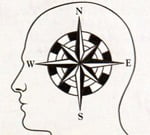 Mental imagery has, until recently, fallen within the purview of philosophy and cognitive psychology. Both enterprises have raised important questions about imagery, but have not made substantial progress in answering them. With the advent of cognitive neuroscience, these questions have become empirically tractable. Neuroimaging studies, combined with other methods (such as studies of brain-damaged patients and of the effects of transcranial magnetic stimulation), are revealing the ways in which imagery draws on mechanisms used in other activities, such as perception and motor control. Because of its close relation to these basic processes, imagery is now becoming one of the best understood ‘higher’ cognitive functions.
Mental imagery has, until recently, fallen within the purview of philosophy and cognitive psychology. Both enterprises have raised important questions about imagery, but have not made substantial progress in answering them. With the advent of cognitive neuroscience, these questions have become empirically tractable. Neuroimaging studies, combined with other methods (such as studies of brain-damaged patients and of the effects of transcranial magnetic stimulation), are revealing the ways in which imagery draws on mechanisms used in other activities, such as perception and motor control. Because of its close relation to these basic processes, imagery is now becoming one of the best understood ‘higher’ cognitive functions.